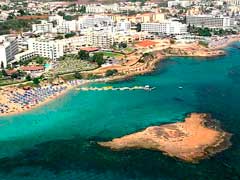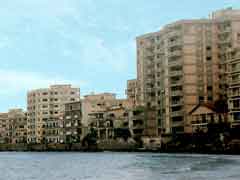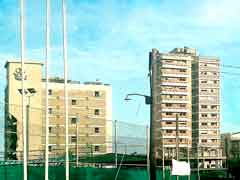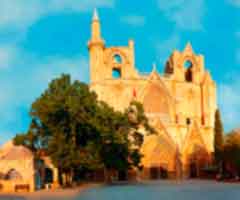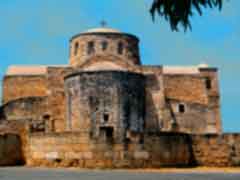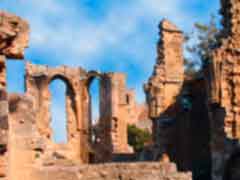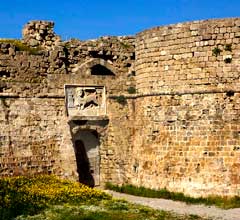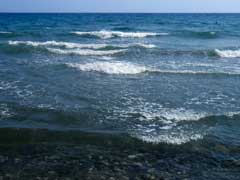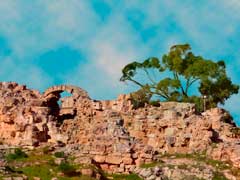Famagusta.
Famagusta (Gazimagusa) is renowned for its golden beaches and ancient history that dates back to the 3rd century BC. Over the course of its existence, the city has witnessed numerous dramatic events, giving rise to remarkable legends and capturing the interest of tourists. The city is connected by a highway to Nicosia, leading to the gates of Famagusta, which are the most beautiful gates of the ancient walls of Nicosia.
History.
It is believed that Famagusta was founded on the ruins of an ancient settlement called Arsinoe. In 1190, Richard the Lionheart landed on the shores of Cyprus, captured Famagusta and Nicosia, and declared himself the new ruler of Cyprus.
Until the end of the Crusades, Famagusta was just a small fishing village, but it rapidly developed in the 14th century. Initially, Famagusta was under the control of Genoese merchants, and later, the Venetians, who turned the city into one of the wealthiest centers in Europe. New quarters designed by Leonardo da Vinci were emerging one after another. In 1570, Famagusta was besieged by the troops of the Ottoman Sultan Selim. Several times, the Venetians heroically repelled the attacks of the Turks, but when the fortress ran out of provisions, they were forced to surrender. The capture of the city by the Turks marked the beginning of the Ottoman era in the history of Famagusta. During the period of British colonization, Famagusta served as a fortified seaport. Only after Cyprus gained its independence, the city seemed to come alive and transformed into one of the most sought-after tourist resorts on the island.
Vorosha.
Vorosha is a ghost town. In the early 1970s, a new quarter called Vorosha (New Famagusta) with modern entertainment complexes, luxurious hotels, and beaches appeared in the southwestern part of the city. Movie stars, celebrities, and businessmen opened restaurants and nightclubs, and tourists booked hotels years in advance. However, the invasion of the Turkish army in 1974 completely paralyzed the cultural and economic life of the city. Vorosha was looted and fenced off. Greek Cypriots were given only 24 hours to leave the city, taking only what they could carry in their hands.
The quarter remains closed to this day, even for journalists. As a result, numerous legends and beautiful stories have emerged about shops filled with fashionable clothing of that time, fully furnished hotels, and magnificent cars in parking lots. Nevertheless, it is known that Vorosha was looted in the early years of the Turkish occupation, and what the Turks could not take with them was left to looters. Many buildings even had their window frames removed.
The four-kilometer strip of golden sandy beach has been deserted for many years, and the partially ruined hotels and cafes of Vorosha are just a silent reminder of the island's division. That is why Jan Olaf Bengtsson, a Swedish journalist, once called Vorosha a "ghost town." Several times the Republic of Cyprus and Northern Cyprus have tried to resolve the conflict regarding Vorosha, but the parties have not been able to reach an agreement. Today, the quarter is considered a neutral territory, but it is still under the control of the Turkish authorities. Nevertheless, the rest of Famagusta, inhabited by Turkish Cypriots, remains an attractive cultural center.
Cathedrals of Famagusta.
The Cathedral of St. Nicholas - Lala Mustafa Pasha Mosque.
Lala Mustafa Pasha Mosque is now the name of one of the main cathedrals in Cyprus and undoubtedly the most majestic cathedral in Famagusta. It was built in 1312 and consecrated in 1328 in honor of St. Nicholas. For over one hundred and fifty years, the exiled Lusignan kings of Cyprus, who were expelled from Jerusalem by the Arabs, were crowned under these ancient vaults. In the mid-14th century, thanks to the Cathedral of St. Nicholas, a miracle occurred. After the service and the subsequent procession, the plague that was tormenting all of Europe at that time left Famagusta!
The Venetians, who replaced the Lusignans, ruled for another hundred years, and in 1571, Famagusta fell under the pressure of the Ottomans. The cathedral, damaged by an earthquake before the siege (the towers were damaged), came under artillery fire. But the destruction of the temple did not end there. The new owners destroyed all the statues, crosses, and frescoes, turning the cathedral into the Ayia Sophia Mosque and adding a minaret to it.
The last war that divided the island into the north and south gave the mosque a new name - Lala Mustafa Pasha. There is another attraction here. Next to the western facade of the cathedral, a silent witness to the tragic history of the temple spreads its powerful crown - a sycamore tree, one of the types of fig trees. Despite its venerable age, and according to legend, it was planted in 1220, it still delights guests and residents of the city with delicious fruits.
This is how the partially ruined but still majestic Cathedral of St. Nicholas - Lala Mustafa Pasha Mosque appears to modern observers.
The Monastery of St. Barnabas.
The Monastery of St. Barnabas is located not in Famagusta itself, but 10 kilometers to the north, near the ruins of Salamis, the city where Barnabas was born
Being originally a Jew, St. Barnabas embraced Christianity and upon his return to Cyprus from the Holy Land, he began preaching the faith in Christ, for which he suffered a martyr's death at the hands of his fellow citizens.
His incorruptible relics were later discovered in 477 AD, and at that time a church was built, which unfortunately was completely destroyed by the Arabs in the 7th century. In 1750, a monastery was erected on the site of the church.
Currently, the monastery houses an exhibition of objects found during the excavations of Salamis. In the church built within the monastery, there is an exposition of icons from various eras. Near the cathedral, above the place where the saint's grave was located, a chapel was erected.
The Cathedral of Saints Peter.
The Cathedral of Saints Peter and Paul was built around 1360 during the heyday of Famagusta as the main trading center during the reign of the Crusaders on the island. The legend of the church's construction speaks eloquently of the wealth of the city and its inhabitants - it is said that only one-third of the money earned by the merchant Simone Nustrano from one deal was enough to build the cathedral! The beauty of the church is attested by a contemporary account - it was "the most beautiful and appropriately sized, and of very majestic construction"
In 1571, Famagusta was captured by the Turks after a prolonged siege, and the fate of the Cathedral of Peter and Paul was shared by all Christian sanctuaries of Cyprus. All frescoes, statues, and other Christian attributes were destroyed, and a minaret was added to the southwest corner, and the church became the Sinan Pasha Mosque.
During the British rule, the mosque served as a grain storage facility, then as an administration building, and later as a library. Currently, the cathedral is undergoing restoration, and it may soon become a museum.
Remains of the former splendor of the cathedral.
The portal of the northern entrance with four embedded marble columns topped with intertwined capitals adorned with leaves. In the middle zone, some surviving but impersonalized images of people remain, including that of Saint Michael protecting the righteous. In some places, the original floor covering made of yellow and black triangular marble pieces has survived. On the western wall, a partially faded image of a ship can be seen. At the very top of the northern wall, traces of a fresco with figures of people, presumably the Forty Martyrs of Sebaste, have survived
Church of St. Francis.
The Church of St. Francis was built in the early 14th century by King Henry II and was part of a monastery that no longer exists. Today, only ruins remain of the majestic Church, just like the chapel.
The Old Town.
The ancient walls of the Old Town are the best-preserved fortifications from the Venetian period on the island. In the 16th century, the height of the walls reached 15-17 meters. Outside the fortress, there was a deep canal built of stone and filled with seawater, so the city could only be entered through the land gates or the sea gates from the port
Inside the Old Town, there are numerous narrow streets with surviving buildings from the medieval and Renaissance eras, intersecting and converging haphazardly at the central square. Local cafes nestled in the ruins of old houses are renowned for their excellent Turkish coffee.
A special place of "pilgrimage" for tourists is the Castle of Othello. It is said that it is here where the story of the jealous Moor, as described by Shakespeare, was born. According to legend, the governor of Cyprus, Christopher Moro, killed his wife, accusing her of infidelity, and threw her body into the sea. Now a lighthouse stands at that spot. From the tower of Othello, there is a magnificent view of the sea gates and the bustling port. Legends abound that this tower hides all the wealth of Venetian merchants who left the city during the Ottoman siege.
The Giovanni Revera Palace with its ancient statues, cannons, and marble sarcophagus is also worth attention.
If you want to see the city from above, head to the Ravelin Bastion. Here you will find one of the first Muslim madrasas on Cyprus. The Jambulat Bastion has become home to the Historical Museum, which houses various artifacts of antiquity, such as weapons, ceramics, Turkish costumes, maps from the period of the Ottoman siege, and more. Famagusta is also known for its first university in Cyprus - Eastern Mediterranean University, with a vast library and a student campus.
Transport.
The most convenient way to get around Famagusta is by car, which can be rented. Alternatively, you can explore the city on foot during a leisurely stroll.
Where to stay?
There are both five-star hotels (Palm Beach Hotel) and budget options available in the city. There are also bungalow complexes (Kocaries Holiday Village) located along the coast.
Shopping.
The best place for shopping is Salamis Road, where you'll find most of the clothing and souvenir shops. Don't miss the stalls with Cypriot handmade lace.
Where to dine?
Restaurants and cafes are scattered everywhere. You can try delicious Turkish kebabs at D&B Cafe and Aspava, or grab a quick bite at Monk's Inn Bistro.
Salamis
Ruins Salamis Just 7 km from Famagusta are the ruins of the ancient city of Salamis. According to Greek myths, this city was founded by Teucer, the hero of the Trojan War. The king of the island of Salamis, Teucer's father, accused him of being involved in the death of his brother Ajax, which forced him to go into hiding. In memory of his homeland, Teucer named the new settlement Salamis. Tourists can admire the architecture of the Roman amphitheater, the partially ruined baths with remains of mosaic panels, and basilicas. Salamis was visited by the apostles Mark and Barnabas during one of their missionary journeys.
The monastery on the outskirts of Salamis is named after the apostle Barnabas, and his tomb is located in a small chapel there.







